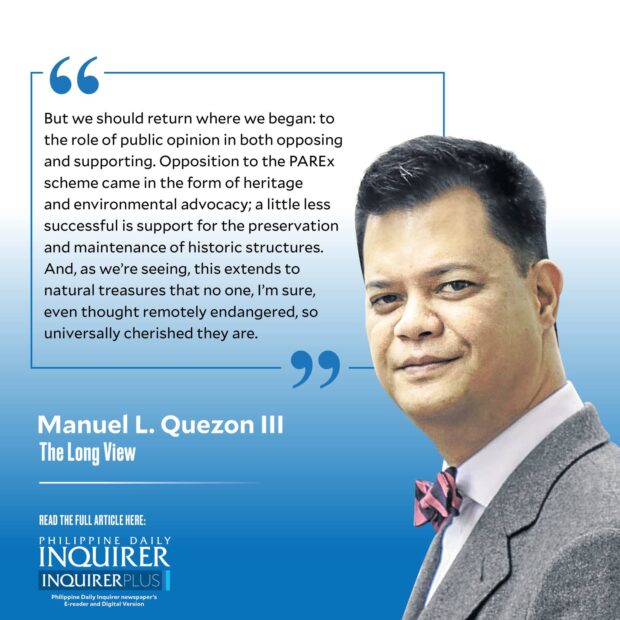Public opinion still has clout

Yesterday’s front page proved that public opinion can still make a difference. Our Business section reported Ramon Ang announcing that his Pasig River Expressway (PAREx) scheme to build a giant expressway along and over the Pasig River, has been dropped, with Ang saying he chose to be “sensitive” to public opinion. It may just be that Manila’s experiment with reviving the Pasig River waterfront by means of getting Paulo Alcazaren—the architect behind Iloilo’s massively popular river esplanade development—to show the feasibility of replicating Iloilo’s success in Manila, was the cultural and tourism proof of concept that killed Ang’s scheme. The only question now is whether the formal abandonment of the PAREx scheme means a Pasig River Esplanade will now get the buy-in not just of Manila’s but other river-bordering cities and municipalities of the Metro.
Anyone who follows Alcazaren’s writings in another broadsheet or on Facebook knows that he has ideas for integrating the entire prospectus from the Agrifina Circle where the National Museum’s buildings are, with Rizal Park all the way to Intramuros and the Post Office Building. According to him, they should all be a walkable heritage zone, which radically expands, by linking together, formerly isolated green spaces while also making formerly detached zones more cohesive. Long a white elephant after the postal system essentially collapsed because of obsolescence, the Post Office Building would have made a good Supreme Court (or even Senate, considering the institution’s eccentric allergy to relocating to its logical location, the Batasan Complex). There have even been proposals to turn it into the National Archives, a splendid purpose only marred by proximity of the building to the river.
Even with the building in ruins, it’s fitting that its Pasig River frontage has become the proving ground for the Manila esplanade experiment. As always, it will now be a race against time: even as the idea is being shown to be possible, the question remains whether the buildings that are notable and historic along the banks of the river can still be saved. What will help is that whatever happens, Manila will be part of the Asean 2026 hosting of the country and a redeveloped historic core would finally put us on par with our neighbors, who caught up with, and then surpassed us, in recognizing that historic preservation makes economic sense. Just as culture isn’t a luxury, but rather, a necessity: or as those who like to make an economic case for it like to say, “a key element in product differentiation.”
Article continues after this advertisementThat being said, it may be ripe for a discussion on whether the time for a Department of Culture has finally come. The compromise in the past, during culturally allergic administrations, was to disguise things under a bureaucratic condominium known as the National Commission for Culture and the Arts, where our cultural agencies bravely do their work despite the endemic indifference of the powers-that-be (I will always marvel at the fact that much as he had little patience for the “culturati,” the late president Benigno S. Aquino III approved the allocation of significant resources for the National Museum and other agencies; perhaps the time will come when the quiet support of previous administrations such as those of presidents Fidel Ramos and Gloria Macapagal Arroyo will be more widely recognized). I noticed that the more visionary of our secretaries of tourism always took a strong interest in culture and the arts and I wonder if the decision of other countries to have a department or ministry of culture and tourism isn’t a logical one.
But we should return where we began: to the role of public opinion in both opposing and supporting. Opposition to the PAREx scheme came in the form of heritage and environmental advocacy; a little less successful is support for the preservation and maintenance of historic structures. And, as we’re seeing, this extends to natural treasures that no one, I’m sure, even thought remotely endangered, so universally cherished they are. And yet, as we’re seeing with the Chocolate Hills of Bohol, what was unthinkable has proven possible.
No one is angrier than the people of Bohol themselves and their local officials have a lot of explaining to do—with elections on the horizon at that. Is it enough to become an issue in local elections? The irony is that after the destruction of churches, national and local, international, faith-based, and nongovernment organizations, all worked together to bring back what was lost; and yet, what nature created has been harmed—by private greed.
Article continues after this advertisementEmail: mlquezon3@gmail.com; Twitter: @mlq3
















